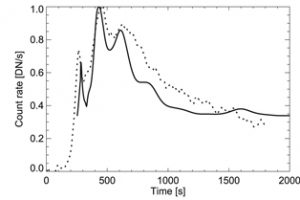Pulsations in the solar corona. The study: “Large-amplitude quasi-periodic pulsations as evidence of impulsive heating in hot transient loop systems detected in the EUV with SDO/AIA” of F. Reale (UNIPA/INAF-OAPA) recently appeared on ApJ

Solar corona is made of plasma at million degrees. The mechanism responsible for the heating of the corona, which is the outer part of the solar atmosphere, is still one of the unsolved problems of solar physics. For comparison, the plasma in the photosphere is on average at about 5600 degrees. It is widely accepted that the responsible for heating the plasma in the solar corona is the magnetic field, which dominates the dynamic of the coronal plasma and whose topology is continuously evolving. Very often, in fact, the magnetic field lines combine in phenomena called “magnetic reconnection events“, during which a large amount of magnetic energy is released.
Coronal loops are the evidence of the interaction between the magnetic field and the coronal plasma and of the capability of the magnetic field of heating the plasma up to million degrees. They are magnetic loops anchored in the photosphere and chromosphere and extended up to the corona, which release large quantities of energy after events of magnetic reconnection. This energy accelerate particles which start flowing downward along the field lines, until they impact the chromosphere releasing their energy to the surrounding plasma after Coulomb interaction. In this way, the plasma around the footprints of the magnetic loops is heated up to million degrees. Since it pressure larger than the surrounding, the heated plasma evaporates filling the magnetic loops and forming the bright flares typically observed in the corona. The impulsive heating events are difficult to be observed, being buried in the chromosphere. However, recent observations made with the NASA probe Interface Region Imaging Spectrograph (IRIS) have shown candidate impulsive heating events at the footprints of coronal loops, which may constitute the smoking gun for the model described above.
The light curves (e.g. the time variation of source brightness) observed in X-rays and UV of coronal flares have a typical shape: a peak of intensity produced when the hot plasma fill the magnetic loop followed by a decline due to the cooling of the confined plasma. Very often oscillations are observed during the decay of the light curves. To explain these oscillations, the astronomer F. Reale (University of Palermo and INAF – Astronomical Observatory of Palermo) has developed a hydrodynamic model which predicts the formation of a pressure front at each footprints of the magnetic loop after the impulsive heating event. The two pressure fronts move across the loop interacting at the loop apex, producing standing pressure weaves inside the loop which result in the oscillations observed in the loop emission during the decay phase.
Recently, the team led by F. Reale has extracted and analyzed the UV light curves from Solar Dynamics Observatory (SDO) observations of some the magnetic loops where IRIS has observed the candidate impulsive heating events. These light curves show the typical oscillations, which are well described by the model of the pressure front moving inside the loop. Since, in order to produce such pressure fronts, it is necessary that the energy is released at the loop footprints in an impulsive event, the agreement between the observed light curve and those predicted by this model provide a further evidence that the events observed by IRIS are impulsive heating events preceding the coronal flares. The model predicts that the impulsive events duration is of about 30 sec and that they released energy with a rate of 1010 erg/cm2/sec, heating the plasma up to 8 million degrees. The study is described in the paper: “Large-amplitude quasi-periodic pulsations as evidence of impulsive heating in hot transient loop systems detected in the EUV with SDO/AIA“, recently appeared on the journal The Astrophysical Journal.
The figure (link) shows the light curves produced by the hydrodynamic model applied to one of the analyzed flares, in the case in which the heating is provided by a short event of energy released at the footprints of the loops (solid line), compared with the observed light curve (dashed line).
by Mario Giuseppe Guarcello ( follow mguarce)
